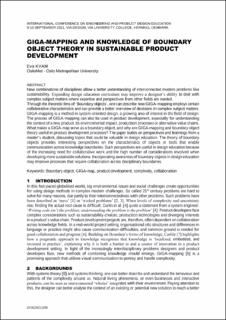| dc.contributor.author | Kvam, Eva | |
| dc.date.accessioned | 2022-02-23T09:11:01Z | |
| dc.date.available | 2022-02-23T09:11:01Z | |
| dc.date.created | 2022-01-04T19:06:17Z | |
| dc.date.issued | 2021 | |
| dc.identifier.isbn | 978-1-912254-14-9 | |
| dc.identifier.uri | https://hdl.handle.net/11250/2980912 | |
| dc.description.abstract | New combinations of disciplines allow a better understanding of interconnected modern problems like
sustainability. Expanding design education curriculum may improve a designer’s ability to deal with complex subject matters where expertise and perspectives from other fields are needed. Through the theoretic lens of ‘Boundary objects’, one can describe how GIGA-mapping employs certain collaborative characteristics and can provide a better overview of decisions in complex subject matters. GIGA-mapping is a method in system-oriented design, a growing area of interest in the field of design. The process of GIGA-mapping can also be used in product development, especially for understanding the context of a new product, its environmental impact, production processes or alternative value chains. What makes a GIGA-map serve as a boundary object, and why are GIGA-mapping and boundary object theory useful in product development processes? The paper builds on perspectives and learnings from a master’s student, discussing topics that could be valuable in design education. The theory of boundary objects provides interesting perspectives on the characteristics of objects or tools that enable communication across knowledge boundaries. Such perspectives are useful in design education because of the increasing need for collaborative work and the high number of considerations involved when developing more sustainable solutions. Incorporating awareness of boundary objects in design education may improve processes that require collaboration across disciplinary boundaries. | en_US |
| dc.language.iso | eng | en_US |
| dc.publisher | The Design Society | en_US |
| dc.relation.ispartof | DS 110: Proceedings of the 23rd International Conference on Engineering and Product Design Education (E&PDE 2021), VIA Design, VIA University in Herning, Denmark. 9th -10th September 2021 | |
| dc.relation.ispartofseries | E&PDE;DS 110: Proceedings of the 23rd International Conference on Engineering and Product Design Education (E&PDE 2021), VIA Design, VIA University in Herning, Denmark. 9th -10th September 2021 | |
| dc.rights | Navngivelse-Ikkekommersiell 4.0 Internasjonal | * |
| dc.rights.uri | http://creativecommons.org/licenses/by-nc/4.0/deed.no | * |
| dc.subject | Boundary objects | en_US |
| dc.subject | GIGA-maps | en_US |
| dc.subject | Product development | en_US |
| dc.subject | Complexity | en_US |
| dc.subject | Collaboration | en_US |
| dc.title | Giga-Mapping and Knowledge of Boundary Object Theory in Sustainable Product Development | en_US |
| dc.type | Conference object | en_US |
| dc.description.version | publishedVersion | en_US |
| cristin.ispublished | true | |
| cristin.fulltext | original | |
| cristin.qualitycode | 1 | |
| dc.identifier.doi | https://doi.org/10.35199/EPDE.2021.58 | |
| dc.identifier.cristin | 1974728 | |
| dc.source.pagenumber | 6 | en_US |

